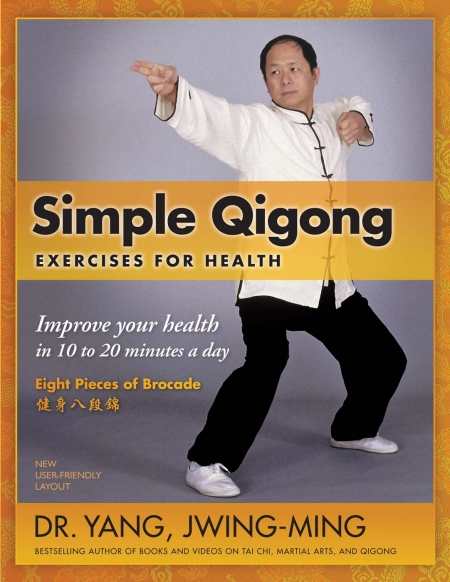Simple Qigong Exercises for Health 2nd ed. rev.
The Eight Pieces of Brocade
A wealth of information and smartly organized chapters put a scholarly bent on this form of Eastern exercise.
Simple Qigong may be a curious title for Yang, Jwing-Ming’s manual of Chinese exercises for improving health. A regimen requiring forty pages of introduction, history, philosophy, and training theory before the first exercise routine can be practiced is, arguably, anything but simple. Thus, Yang, Jwing-Ming second edition revised manual is not for the feint of heart; rather, it requires patience and perseverance (the “gong” of qigong) to master new concepts, Chinese terminology, and a non-Western approach to understanding body parts, their relationships, and how they influence the life force within, known as qi. However, students willing to devote the time and energy required to comprehend the principles of qigong will be richly rewarded with an exercise plan that is, indeed, simple to perform and can be completed in fewer than twenty minutes per day.
The book is well organized. It begins with requisite definitions and a brief history of the thousand-year-old practice, strongly rooted in both military and religious traditions, particularly Buddhism and Daoism. Yang, Jwing-Ming explains concepts essential to grasping qigong: the human body’s twelve channels, eight vessels, and three paths, and the two exercise levels or “elixirs” (introductory wai dan and advanced nei dan, excluded because these exercises can “cause crippling, paralysis, or even death”).
Chapter 2 is challenging because qigong theory is multifaceted and uses dozens of Chinese words and symbols. The eleven-page glossary is useful in deciphering this section. The remaining two chapters provide the qigong “Eight Pieces of Brocade” exercises, the first set completed while sitting, the second while standing. Photographs with graphics depicting direction of body movements clearly guide exercise routines.
The introductory chapters are informative, but also repetitive, reminding readers multiple times that different forms of Eight Pieces of Brocade exercises exist, and that it is essential to understand the poem that explains each exercise. Literal translation of poems can make comprehension difficult, however: “Seal the breath and rub hands (until) hot, massage the rear essence door (on your) back, end this one mouthful of breath, think (image) the fire is burning the belly wheel.”
In addition, the book makes some assertions which, if not impossible, at least stretch credulity, such as claims that qigong can cure asthma, ulcers, and certain kinds of cancer. It also asserts that many monks who have used these techniques “lived more than 150 years”—in some cases as long as 200 years. The author provides sources for his claims, but the references do not appear scientific. Yang, Jwing-Ming gives many of the citations only in Chinese symbols, so it is difficult for Westerners to authenticate his statements.
Yang, Jwing-Ming has been involved in Chinese martial arts for over fifty years. As president of Yang’s Martial Arts Association (YMAA), he has written three dozen books, produced eighty videos, and maintains more than fifty-five training schools in eighteen countries.
Simple Qigong is likely to appeal to health enthusiasts and advocates of yoga, tai chi, and the martial arts. Because the exercises can be completed by people of almost any age and ability, a wider audience—particularly individuals with a scholarly bent—may be drawn to this manual describing simple exercises intended to promote health and well-being.
Reviewed by
Nancy Walker
Disclosure: This article is not an endorsement, but a review. The publisher of this book provided free copies of the book and paid a small fee to have their book reviewed by a professional reviewer. Foreword Reviews and Clarion Reviews make no guarantee that the publisher will receive a positive review. Foreword Magazine, Inc. is disclosing this in accordance with the Federal Trade Commission’s 16 CFR, Part 255.

